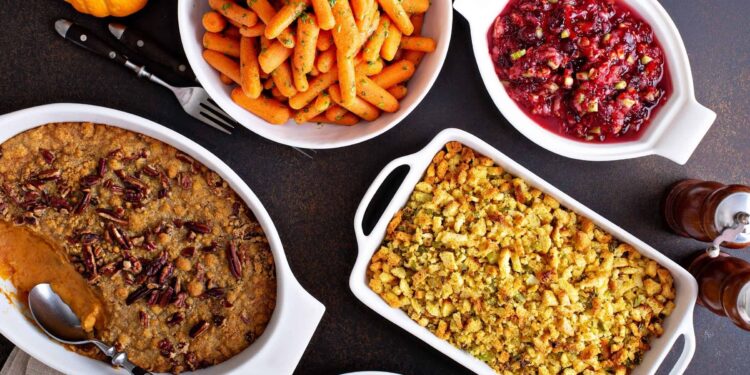Thanksgiving is almost here along with the memories, the family, the friends, the food.
And then there’s the anxiety of preparation and the heavy, bloated aftermath, that sometimes continues into the rest of the week as you savor the leftovers and the freedom of not having to cook for a few days.
Is it possible to enjoy the day, the feelings of gratitude, the love, the abundance without these side effects? The answer is yes! With a little planning you can create a Thanksgiving (or other holiday) feast that everyone enjoys following Ayurvedic principles.
Calm and Balanced
The essence of Ayurveda is balance—physical, mental, emotional and spiritual. If any of these are off, it’s hard to enjoy your day.
Prepare in advance by noticing what it’s like when you feel really good. Then pay attention to how you feel when you contemplate the big day and all you have to do to get prepared.
Are you flustered? Anxious? Is your blood pressure rising? Do you have hives or other skin eruptions? Is your gut upset? Here are some ways to keep calm as the day approaches.
Practice meditation or calming practices like alternate nostril breathing or SKY breath meditation. It’s easy to decide you don’t have time, but it’s when you are under stress that you need these practices the most.
Use some of the many free or inexpensive apps designed to keep you organized. There are timer apps to help you keep track of what needs to go in or come out of the oven and when, apps like Out of Milk to assist with managing multiple shopping lists, and recipe apps such as Oh She Glows, a thoughtful collection of plant-based options.
If you are serving turkey, there are apps to help you decide how much to buy or how long to cook it, and educate you on the many ways to fix it to keep everyone happy with the results. It is super important to cook your meat with plenty of herbs and spices to aid digestion. Especially turmeric.
There are even a handful of Ayurveda apps such as Dosha Diet that can help with food planning from an Ayurvedic perspective.
You may not normally link Ayurveda—which is 5,000+ years old—and technology. But if it helps keep you calm and in the moment it is definitely in sync with Ayurveda. Look in your app store for what is available for you.
Doshas and Tastes
Food choices impact balance. We all have different constitutions—doshas—which can shift in and out of balance by the season and even by the day. So how do you plan a holiday dinner that is balancing for everyone?
Ayurveda teaches that food can be categorized into six tastes: sweet, sour, salty, bitter, astringent (drying) and pungent (spicy). Each of the three doshas can be balanced by three of the tastes and aggravated by the other three. For vata, balance requires tastes that are sweet, sour and salty, Pitta, sweet, bitter and astringent and kapha bitter, astringent and pungent.
While all of that may seem complicated at first, you can simplify your planning by including a few of each of the six tastes in your menu.
Most traditional Thanksgiving dinners are loaded with sweet, sour and salty tastes, which tend to be heavy. It’s no wonder we feel weighed down afterwards and swear we won’t eat again for at least a week.
Sweet, sour and salty are great for the vatas at the table (although even for them too much is unbalancing), not so good for kaphas for whom all three tastes are aggravating. Sweet tastes pacify Pitta, but they will be aggravated by sour and salty.
Bottom line, when planning your menu, balance sweet, sour, and salty by including foods that have bitter, astringent, and pungent qualities.
Meat, bread, rice, sugar, vegetables like sweet potatoes and pumpkin, almonds, milk, and eggs are considered sweet. Sour tastes that make your mouth pucker and your saliva flow include lemons and limes, cheese, vinegar, pickles, sour cream, and yogurt. Salty foods include seaweed, soy sauce, or miso. While these aren’t typically part of Thanksgiving menus, many of us make generous use of the salt shaker, especially when we sit down to a big dinner.
Spicy foods like chilis, cayenne peppers, garlic, and onion are pungent. Bitter foods are leafy greens (like kale or collards), coffee, black or green tea, and dark chocolate. Astringent (drying) foods include broccoli and cauliflower, dried beans, apples, pears, and cranberries.
When you include all six tastes in your menu, not only will you keep everyone happy and balanced, but they will also get a full range of nutrients as well.
Another thing to keep in mind when planning your meal is the best time to eat. Your digestive fire is strongest between 11:00 am–2:00 pm, which makes these the best hours in which to enjoy a big holiday feast.
Follow your meal with a long walk to help speed digestion.
Menu Ideas
When planning an Ayurveda inspired holiday meal, your first question may be what about meat? Is it permitted? Isn’t Ayurveda synonymous with being vegetarian?
Like any food, meat is considered a positive in Ayurveda if it helps you achieve balance. Many sources suggest vatas in particular may need meat occasionally to help ground them, but too much may tax their digestion. As we said earlier, be sure to season your meat with plenty of herbs and spices to aid digestion.
In general, vegetables are considered superior because they are easier to digest and promote calmness and clear headedness, while meat can leave you feeling dull and heavy.
Turkey’s taste is sweet, but its heaviness makes digestion challenging. Pittas, with their strong digestion, tolerate it best, while vatas and kaphas would benefit from eating smaller portions.
Here are some ideas for a menu that includes all six tastes, including a vegan entrée that will hold its own alone or alongside a turkey.
MENU
Pumpkin Soup with a Touch of Pesto
Stuffed Roasted Butternut Squash
Roasted Acorn Squash
Fermented Cranberry Relish
Mashed Potatoes with Green Onions
Brussels Sprouts with Pickled Red Onions
No-Bake Apple Pecan Pie









